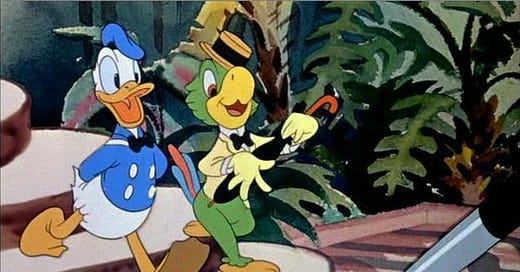How you define the start of the era in which Disney Animation made so-called “package films” really depends on how much leeway you extend to the Golden Age of the studio’s animation. If you watch movies like Snow White and the Seven Dwarfs and Pinocchio, it is fairly simple to look at them in a certain way and recognize that these classics, too, are packages of a sort. Animation fans think of the package era of Disney Animation as being limited primarily to the 1940s, and while the moniker fits when you think about the films released during that decade, even Disney’s best early films (and some of the films they made in the 1950s) have the air of being sequence-driven.
For many of us, the package era of Disney Animation starts with the film I’m covering in today’s essay, the 1942 feature Saludos Amigos. But if you’re relatively pedantic (and if you are reading this, it will not come as a shock to learn that I am…at least that pedantic), you could note that Fantasia is really the first package film. Is there a single overarching story? No. Are there discrete parts that make up the whole? Yes. Are there thematic similarities among those parts even as they accomplish their creative aims in different ways? You betcha. Films like Snow White and Pinocchio and Bambi, of course, would seem to be disqualified because each of those titles do tell a single overarching story. But those films have credited sequence directors, and they all do feel sequence-driven. The introduction to the dwarves. The trip to Pleasure Island. Bambi and Thumper sailing through the icy pond. And so on.
The true mark of a Disney package film is the sense that it’s something of a step down from full features. The package era of the 1940s was an era of necessity, of Disney stepping back to the type of animation choices it made in the early 1930s through the Silly Symphonies series of shorts because their budgets had to be lower and they were scrambling to survive. Over time, I have grown to chafe somewhat against this sense; when I watched these films as an adult for the Mousterpiece Cinema podcast I used to co-host, I did initially feel like the slightness of these films contributed to them feeling like redheaded stepchildren. Their very nature almost guarantees that they’re hit-or-miss. But not all of them quite feel as secondary.
Some. Like today’s film. But not all.
Keep reading with a 7-day free trial
Subscribe to That Still, Small Voice to keep reading this post and get 7 days of free access to the full post archives.




